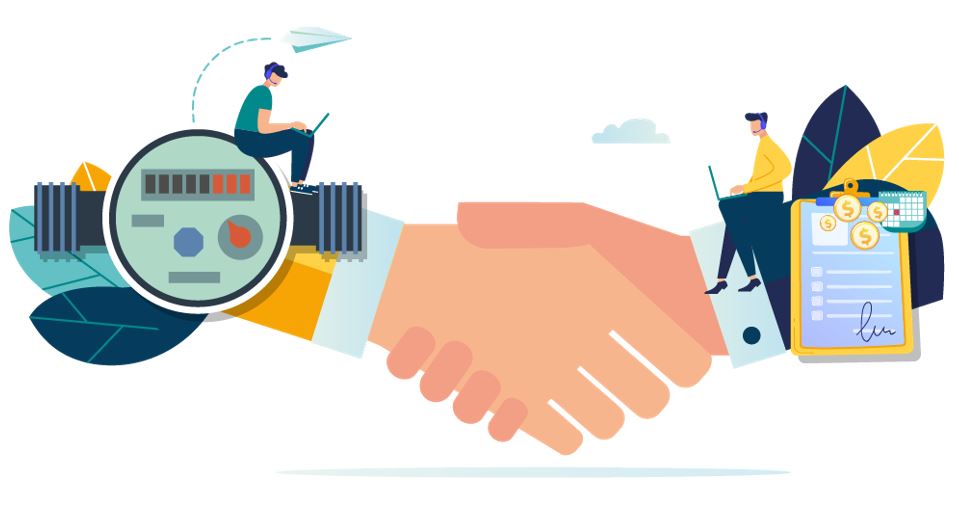As a utility, having AMI infrastructure brings many benefits to your business. However, its deployment presents significant challenges that must be addressed. To successfully introduce smart meters to their customers, service providers should consider adopting a modern system that allows them to face every challenge in acquiring this technology.

In a world where data is the most valuable asset, Advanced Metering Infrastructure (AMI) is extremely beneficial given the amount of information it can produce. Composed by smart meters, sensors, and remotely monitored variables, such as water pressure and pipeline conditions, this infrastructure helps water utilities to increase their operational efficiency and perform to the highest levels by saving time and manpower.
In fact, smart meters allow water utilities to improve the accuracy of their customers´ needs and improve water conservation by allowing companies to detect water leaks earlier than ever. A report prepared for the American Water Works Association says that “a credible range of water savings associated with AMI-based programs falls within a range of 2 to 10%”.
This technology relies on a two-way communication in which utilities and the smart meters involved transmit information, giving service providers the power to turn the devices on and off remotely, update their software, and obtain their usage data in a reliable and agile way.
As a result, implementing an AMI infrastructure can help improve all business processes and lead utilities and consumers to make better business decisions.

As water utilities consider integrating AMI technology into their businesses, many kinds of challenges are bound to arise. Consequently, to successfully deploy smart meters, these service providers require a system that supports them in overcoming every obstacle.
Data management
AMI implementation requires utilities to manage large amounts of data. However, a study done by Dodge Data & Analytics suggests that between half and two thirds of the water utilities in the United States have little or no capabilities to digitally manage asset information in real time. Reliable data management is vital for the business since many processes are derived from it, thus utilities must achieve the ability to benefit from data collected, while maintaining security and reliability.
Enhanced customer experience
As a utility, improving customer expectations and reducing resolution times to achieve greater satisfaction is key to boosting customer loyalty. In fact, according to Gartner, service leaders report that 20% to 40% of the live volume of customer service interactions could be easily resolved using existing self-service capabilities To do so, water utilities should provide customers with omnichannel communications and digital platforms to help facilitate their interactions with their service provider.
System interoperability
Due to the large volume of data collected and processed on a daily basis, it is indispensable to have good communication between every system in order to have a successful AMI deployment. By having system interoperability, utilities can have traceability and reliability of all processes executed.
Workforce management
To achieve a successful transition to smart metering, water utilities must count on a software solution that has the ability to integrate with workforce management systems to plan and execute activities such as meter replacement, and periodic reviews, among others.
Support traditional and smart meters
Given that each customer has a different type of meter installed at their home, it is important that utilities implementing AMI have a system that can support both traditional and smart meters. Moreover, it is vital to cover all of them through meter-to-cash and customer-to-meter processes.
There is no doubt that implementing new technologies comes with a variety of challenges. When it comes to AMI, water utilities need to count on a flexible and agile solution to help them tackle every situation and truly take advantage of the benefits that this infrastructure has to offer.

With these obstacles in mind, Open developed their CIS solution, Smartflex, a key enabler for the transition to smart grids that allows utilities to deliver added value to their customers through end-to-end journeys across meter-to-cash and customer-to-meter processes. This modern solution supports traditional and smart meters and allows utilities to have complete management over all the data collected, such as consumption, quality of service variables, events, and more. Additionally, it supports the deployment of VEE functionalities improving billing accuracy and consistency in all processes.
Open understands how important customer experience is for a utility, which is why Smartflex was designed with a complete self-service portal, where customers can execute processes on their own, like payments, requests, and program enrollments. In addition, the solution helps utilities improve customer satisfaction through proactive interactions, which enable service providers to anticipate customer needs and use artificial intelligence, such as chatbots, to engage with customers. With the use of data analytics, Smartflex can help utilities offer them the best solutions according to their specific needs.
This powerful solution is a three-dimensional extended CIS (MDM – MWM – DCX) with workforce management functionalities, which expands customer service processes to the field and facilitates the transition from conventional to smart meters. Through a holistic approach, the solution simplifies the interaction between the processes of measuring usage, billing, and customer engagement. Its optimal communication between systems and data exchange through web services truly delivers added value to utilities.
As utilities continue to move towards a more digital and innovative future, Smartflex is the modern CIS that will empower utilities to make the change to smart meters. With its extensive functionalities, Open’s solution will enable service providers to achieve a successful and smooth AMI deployment, from data management and customer experience, to interoperability between systems.







